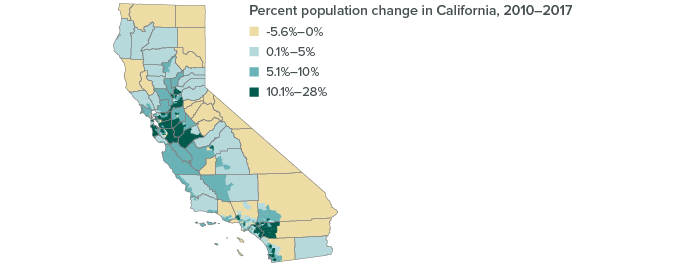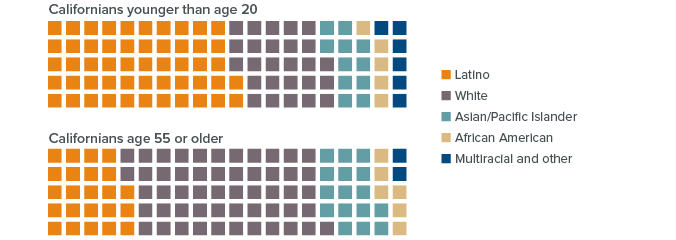- The 2020 Census will provide a comprehensive snapshot of California.
Every 10 years, as required by the Constitution, the US government undertakes a systematic effort to count the population—culminating in a portrait of the nation, states, and communities unrivaled in its scope. With a $15.6 billion budget, the Census Bureau will aim to gather a few key facts about all residents—address, age, race/ethnicity, home ownership, and household members—as of April 1, 2020. For the first time, the agency will try to collect most responses (55%) online, with the remainder by mail or, as needed, in person. - An undercount could affect California’s political representation in Congress.
The decennial census is the sole basis for reallocating the 435 seats in the US House of Representatives. Given recent population trends, California is likely to maintain its 53 seats. But if the census does a poor job of reaching hard-to-count populations and immigrant communities, it could miss more than 1.6 million residents—and the state could easily lose a seat. The census will also be used to redraw district lines; its accuracy is essential to correctly representing local communities.
The 2020 Census will realign political representation based on areas of population growth

SOURCE: PPIC calculations from 2010 Census and 2017 American Community Survey data, via IPUMS-USA (University of Minnesota).
NOTE: California counties are shown on the map, with sub-county population information shown where available. These sub-county areas are public use microdata areas (PUMAs), which each contain roughly 100,000 residents. Counties with fewer than 100,000 residents are grouped.
- The US government uses the census count to distribute billions of dollars every year.
The census count lays the foundation for many federal programs to deliver resources on a per capita basis or to specific populations, such as young children in poverty. In fiscal year 2016, California received an estimated $115 billion in federal funding tied to the state’s population count. For some programs, such as Medi-Cal (the state’s Medicaid program), California’s base federal funding allocation is subject to a strict minimum level. But for others, like the Children’s Health Insurance Program, an undercount could put funding at risk. - Many stakeholders rely on the census to learn about California’s changing population.
The federal government uses census data to develop and conduct annual surveys that offer detailed insights into the state’s demographic composition, economic well-being, and housing situation. Governments, K–12 and higher education institutions, businesses, and nonprofits depend on this information to understand the needs of their communities, target services, and plan for the future. Estimates suggest California has grown by 2.3 million residents and become more diverse since the 2010 Census.
The 2020 Census will reflect California’s growing racial and ethnic diversity

SOURCE: PPIC calculations from 2017 American Community Survey data.
NOTE: Each box represents roughly 100,000 California residents. About 10 million Californians are in each age group. Each age group includes fewer than 40,000 people who identify themselves as a single race not described by any of the other categories.
- Large segments of California’s population are historically hard to count.
In 2017, about 72% of all Californians (29 million) belonged to one or more groups that the census has historically undercounted, including renters, young men, children, African Americans, and Latinos. Those living in nonstandard housing—conditions exacerbated by the state’s housing crisis—may also be hard to reach. Meanwhile, adding a question about citizenship status may make immigrants and others more reluctant to share information with the government. A number of states, including California, have taken legal action to prevent the addition of this question, with arguments now headed to the Supreme Court. - Implementation hurdles and politicization have intensified accuracy concerns.
Although Congress increased funding for the census and confirmed a new bureau director, the Government Accountability Office continues to designate the 2020 Census at high risk of failure. The Census Bureau has not had time or resources to fully test the 2020 Census, adding to concerns about its success. New technological approaches and the addition of a citizenship question have heightened these concerns. - State and local partners are essential in ensuring an accurate count.
To prepare for the census, state and local governments help verify the Census Bureau’s address lists, an effort that will conclude by summer 2019. These agencies also play a critical role in encouraging participation. California’s budget for census outreach—$100 million in 2018–19, with another $54 million proposed for 2019–20—exceeds that of any other state. These funds are allocated according to the location of hard-to-count communities, with options for local governments, community-based organizations, media, and schools to receive funding. Community and philanthropic organizations are also contributing to outreach efforts.
Sources: Reamer, Counting for Dollars 2020 (GW Institute of Public Policy, 2019); Mule, Census Coverage Measurement Estimation Report (US Census Bureau, 2012); Government Accountability Office, 2019 High Risk Report: 2020 Decennial Census (2019); California Complete Count Office, “Progress Report on Complete Count Office’s Census 2020 Outreach and Communication Program” (2019).
Topics
Health & Safety Net Political Landscape PopulationLearn More

2020 Census: The Political Impact on California

2020 Census: Where Are California’s Hard-to-Count Communities?

Census-Related Funding in California

Policy Brief: How Accurate Was California’s 2020 Census?

The 2020 Census and Political Representation in California

